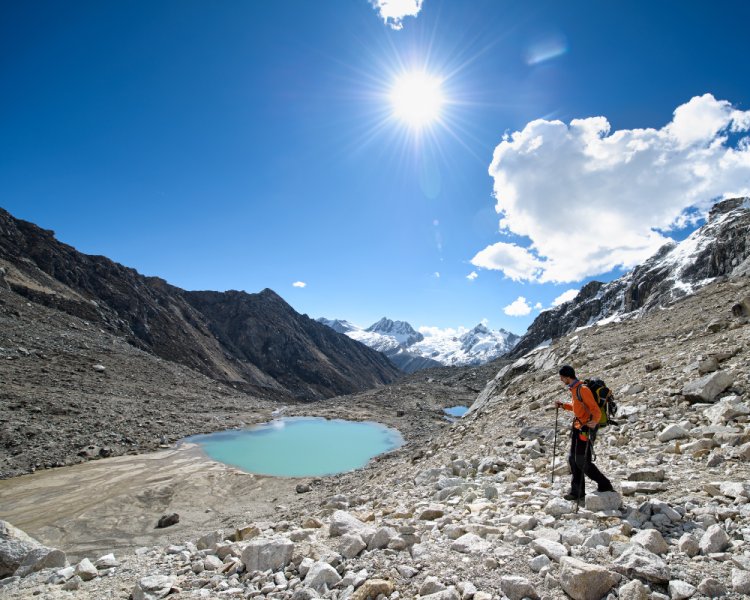Where Is Rudranath Temple Located and How Is It Linked to the Trek?
Located in Uttarakhand, Rudranath Temple is a key spiritual site on the Rudranath trek. Learn how this ancient temple is deeply connected to the sacred trekking route.

Hidden deep within the Garhwal Himalayas, Rudranath Temple is one of the most mystical and spiritually significant destinations for Hindu devotees and trekkers alike. Known for its divine aura, breathtaking natural surroundings, and spiritual importance, Rudranath is one of the Panch Kedar temples dedicated to Lord Shiva. Unlike other temples in the region, Rudranath is not easily accessible — it demands an adventurous and scenic trek through dense forests, alpine meadows, and tranquil mountain villages. This journey is not just a pilgrimage but an immersive experience blending faith, nature, and physical endurance.
In this article, we will explore where the Rudranath Temple is located, the story and mythology behind its origin, and how the Rudranath Trek is intricately linked to its allure.
The Geographical Location of Rudranath Temple
Rudranath Temple is located in the Chamoli district of Uttarakhand, India. Nestled at an altitude of 3,600 meters (11,800 feet) above sea level, the temple lies within a dense forest region inside the Garhwal Himalayan range, specifically in the area of Gopinath Valley.
Geographically, the temple is part of the Kedarnath Wildlife Sanctuary, and reaching it involves traversing some of the most pristine and untouched parts of the Himalayas. The surrounding terrain is filled with alpine meadows (known as bugyals), rhododendron forests, and crystal-clear streams. The temple overlooks deep gorges and is surrounded by snow-capped peaks like Nanda Devi, Trishul, and Nanda Ghunti, making it a haven for trekkers and nature lovers.
The Mythological Significance of Rudranath Temple
Rudranath is the second temple in the Panch Kedar pilgrimage circuit, which comprises five sacred shrines of Lord Shiva — Kedarnath, Rudranath, Tungnath, Madhyamaheshwar, and Kalpeshwar. According to legend, after the Mahabharata war, the Pandavas sought Lord Shiva to absolve them of their sins. Shiva, however, was not willing to meet them and assumed the form of a bull (Nandi) to avoid them.
In the region of Guptkashi, the bull disappeared into the ground. The hump appeared in Kedarnath, the arms in Tungnath, the face in Rudranath, the navel in Madhyamaheshwar, and the hair in Kalpeshwar. These five places collectively became known as the Panch Kedar, and each is a site of a sacred Shiva temple.
At Rudranath, Lord Shiva’s face is worshipped in a natural rock formation within a cave. The locals believe the deity’s presence here is extremely powerful and protective, attracting both pilgrims and seekers of spiritual enlightenment.
How Is the Temple Connected to the Rudranath Trek?
The Rudranath Trek is not just a trail; it's a spiritual passage. To reach Rudranath Temple, there are no direct roads or motorable access points. The only way to reach the temple is through a rigorous trek that starts from several base villages — most notably Sagar Village, Lyuti Bugyal, and Panar Bugyal. Among these, Sagar Village, located 5 km from Gopeshwar, is the most common starting point.
From Sagar, the Rudranath Trek spans approximately 20 kilometers (12.5 miles) one way, and it takes around 2-3 days depending on your pace and weather conditions. The trek includes steep ascents, rocky trails, forest paths, and scenic meadows, which collectively test your endurance while rejuvenating your soul.
The trek to Rudranath is considered moderate to difficult, primarily because of its high altitude, unpredictable weather, and lack of amenities along the way. However, it rewards trekkers with panoramic views of Himalayan peaks, floral diversity, and a unique opportunity to connect with nature and spirituality.
Trek Routes to Reach Rudranath
There are three main trekking routes to reach Rudranath:
1. Sagar Village Route (via Panar Bugyal)
-
Distance: Approx. 20 km (one way)
-
Route: Sagar – Pun Bugyal – Panar Bugyal – Rudranath
-
Highlights: This is the most popular route with a mix of dense forests, grasslands, and stunning viewpoints. Panar Bugyal is often used as an overnight camping spot due to its breathtaking beauty.
2. Lyuti Bugyal Route (from Mandal)
-
Distance: Approx. 17 km
-
Route: Mandal – Lyuti Bugyal – Rudranath
-
Highlights: A lesser-used path but equally mesmerizing with thick oak and deodar forests and abundant birdlife.
3. Anusuya Devi Route
-
Distance: Approx. 24 km
-
Route: Gopeshwar – Mandal – Anusuya Devi Temple – Rudranath
-
Highlights: This path allows you to visit the sacred Anusuya Devi Temple, believed to be the place where the goddess Anusuya performed penance. It adds religious depth to the journey.
Best Time to Visit Rudranath Temple
Rudranath Temple opens for devotees during the summer months, typically from May to mid-October. The best time to undertake the Rudranath Trek is between June and September, when the weather is relatively pleasant, and the trails are accessible.
During winter, the region receives heavy snowfall, and the temple remains closed. The idol of Lord Shiva is shifted to Gopinath Temple in Gopeshwar during this period for worship.
What to Expect on the Rudranath Trek
1. Scenic Landscapes
From thick forests of pine and oak to blooming alpine meadows, the trek presents an ever-changing canvas of the Himalayan ecosystem. Panar Bugyal and Lyuti Bugyal are two of the most picturesque spots along the trek.
2. Spiritual Ambience
Unlike the crowded temples of popular circuits, Rudranath offers a tranquil and meditative atmosphere. The chants of pilgrims, the sound of temple bells, and the serene mountain air create an unforgettable spiritual experience.
3. Simple Facilities
Since the region is remote, accommodation is basic. Local guesthouses, dharamshalas, and tents are available at Panar and near the temple. Food is usually simple vegetarian fare provided by local families or temple caretakers.
Attractions Around Rudranath
1. Vaitarani River (Rudraganga)
It is believed to be the celestial river where souls are cleansed. Pilgrims take a ritual dip here before entering the temple. The river flows quietly near the temple and adds to the sacred aura.
2. Surya Kund and Chandra Kund
These are natural water pools near the temple dedicated to the Sun and Moon deities, believed to possess healing properties.
3. Nandikund
Located further uphill from Rudranath, Nandikund is believed to be the place where Nandi, the bull of Lord Shiva, meditated. It is a serene and relatively unexplored destination for avid trekkers.
Why Rudranath Trek Is a Must for Trekkers and Devotees
The Rudranath Trek stands apart from commercial trekking routes because it combines pilgrimage with adventure. Whether you’re a spiritual seeker or a nature enthusiast, the trail offers something unique:
-
Cultural immersion with local Garhwali traditions.
-
Biodiversity, including rare Himalayan flora and fauna.
-
Sacred significance, making it more than just a physical journey.
-
Low footfall, providing solitude and peace.
This trek is often recommended to those who have already completed Kedarnath or Tungnath treks, looking for a more offbeat and spiritual alternative.
Tips for Planning the Rudranath Trek
-
Physical Preparation: Acclimatize yourself to higher altitudes and ensure good cardiovascular fitness.
-
Travel Light: Carry only essentials — good trekking shoes, warm clothes, rain gear, and basic medicines.
-
Stay Hydrated: Dehydration can strike quickly at high altitudes, so drink plenty of water.
-
Respect Local Culture: The region is sacred to locals; avoid loud behavior, littering, or non-vegetarian food.
-
Permits and Guides: Though permits may not always be required, hiring a local guide is recommended for navigation and cultural insights.
The Inner Journey: More Than Just a Hike
What sets the Rudranath Trek apart is the inner transformation it offers. The combination of physical hardship, pristine nature, and divine energy pushes one toward reflection and humility. It challenges the body while nurturing the spirit.
Many who complete the trek report feeling emotionally lighter, spiritually energized, and deeply connected to the divine. It's not just about reaching the temple — it’s about understanding the journey within.
Conclusion
Rudranath Temple, nestled in the remote heights of Uttarakhand, is more than a religious site — it’s a destination that demands reverence, resilience, and reflection. The Rudranath Trek is not merely a path through forests and mountains; it is a bridge between the earthly and the spiritual.
For anyone seeking a meaningful Himalayan experience, combining devotion with adventure, Rudranath promises a journey that stays with you long after the trek ends. Whether you seek the blessings of Lord Shiva, the thrill of a high-altitude trail, or a break from the chaos of city life, Rudranath delivers on all fronts — silently, sublimely, and spiritually.
What's Your Reaction?

















.jpg)